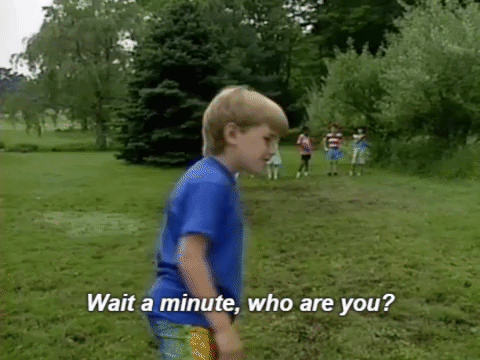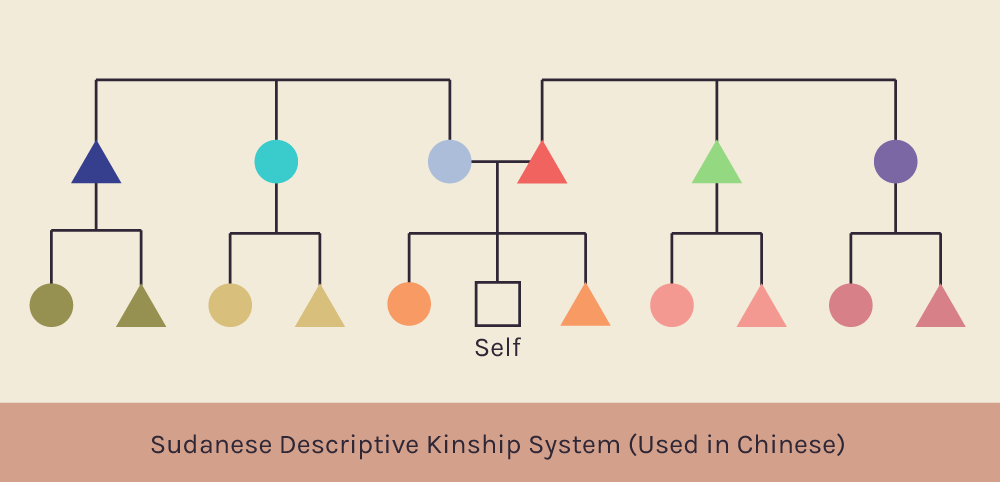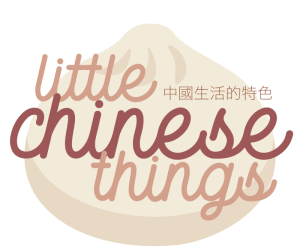If you come from an Asian family, you’ve probably attended your fair share of family gatherings, dinners, functions, etc. You’ve probably also experienced a situation like this at least once in your life:
Mom: greet your family members.
You: *panicking because you don’t know how to address any of them* uHM…

Can’t relate? Either you’ve mastered the art of Chinese kinship terms (in which case, congratulations!), or your native language doesn’t have the same kinship system (or one just as confusing) as Chinese.
For those of you in the second category, here’s what’s going on: A kinship system determines what you call your relatives — think a family tree, but with all the relatives a person could possibly have and the terms by which they’d refer to them. Chinese uses a different kinship system than English. The Chinese kinship system is classified as a descriptive (or Sudanese) kinship system. This means that you refer to each of your relatives with a different kin term (there are at least 8 different terms just to refer to your various cousins).


Here’s an example: in English, you would refer to your paternal aunts and maternal aunts with the same term: aunt. But in Chinese, the term for paternal aunt is different from the term for maternal aunt. Take that concept, and apply it to all the other relatives you have — aunts, uncles, cousins, grandparents, and everyone in between. That’s a lot of terms!
Recently, I attended a family dinner to celebrate my paternal grandfather’s birthday. Naturally, all of my father’s family attended. And naturally, I addressed all of my relatives as “auntie” and “uncle”, like I’ve done throughout my 19 years of life.
Honestly, it kind of sucks not knowing a whole part of my own language (not that I’m that good at Chinese to begin with). I’ve always struggled with addressing my Chinese relatives. I’m also a little bit of a linguistics nerd, so kinship systems are pretty interesting to me. So, I decided to learn the Chinese kinship terms and share what I learnt with all of you!
I’ve provided jyutping (romanization for Cantonese pronunciation — I used CantoDict) in square brackets for each word. Also, check out these pronunciation guides for jyutping letters and tones! Happy learning!
A Quick Primer
Many Chinese kinship terms incorporate words that indicate different types of relations (I’ll call them relation markers), especially relations by blood and by marriage. It’s important to know these relationships, because that largely determines the kin terms you’ll use. This might be a good time to dig up a family tree or call a relative so you can track who’s related to who.
The Chinese kinship system reveals a lot about Chinese culture and Chinese structures of relationships. Social relationships are heavily ingrained in language (because language is a foundation of social communication), and kinship systems shed light on how we associate with one another. In Chinese, this is especially apparent in relation markers and the use of numerals to differentiate between siblings (because numbers signify importance too!).
Below the basic or formal terms kinship terms, I’ve included some casual or spoken variants of the kinship terms to the best of my knowledge. You’ll see those listed below the heading “Casual/Spoken Variants”.
Immediate Family
Let’s begin with your direct relatives. This part is pretty straightforward — no fancy relation markers here. Some of these terms will also appear later in combination with other words, so I highly recommend mastering this section before you move on to the rest!
| English | Cantonese |
| Mother | 媽媽 [maa1 maa1] Casual/Spoken Variants: 媽咪 [maa1 mi4] 老媽子 [lou5 maa1 zi2] |
| Father | 爸爸 [baa1 baa1] Casual/Spoken Variants: 爹哋 [de1 di6] 老豆 [lou5 dau6] |
| Older Brother | 哥哥 [go1 go1] Casual/Spoken Variant: 大哥 [daai6 go1] |
| Older Sister | 姐姐 [ze2 ze2] Casual/Spoken Variant: 家姐 [gaa1 ze2] |
| Younger Brother | 弟弟 [dai6 dai6] Casual/Spoken Variant: 細老 [sai3 lou5] |
| Younger Sister | 妹妹 [mui6 mui6] Casual/Spoken Variant: 細妹 [sai3 mui6] |
| Husband | 老公 [lou5 gung1] |
| Wife | 老婆 [lou5 po4] |
| Son | 仔 [zai2] |
| Daughter | 女 [neoi5] |
Grandparents and Great-Grandparents
Moving a generation up to grandparents, kinship terms are now different on either side of the family (maternal and paternal). In some of these terms you’ll see the relation marker “外” [ngoi6]. “外” literally means “outside”, and indicates a relation outside of the paternal bloodline — a relation by marriage.
| English | Cantonese |
| Paternal Grandmother | 嫲嫲 [maa4 maa4] |
| Paternal Grandfather | 爺爺 [je4 je4] |
| Maternal Grandmother | 外婆 [ngoi6 po4] Casual/Spoken Variant: 婆婆 [po4 po4] |
| Maternal Grandfather | 外公 [ngoi6 gung1] Casual/Spoken Variant: 公公 [gung1 gung1] |
| Paternal Great-grandmother | 太嫲 [taai3 maa4] |
| Paternal Great-grandfather | 太爺 [taai3 je4] |
| Maternal Great-grandmother | 太婆 [taai3 po4] |
| Maternal Great-grandfather | 太公 [taai3 gung1] |
Uncles and Aunts
Here’s where I had (and still have) the most trouble — differentiating between aunts and uncles and their spouses proves to be an arduous task. Sometimes, it’s hard to trace the relationships between yourself and your aunts and uncles too (because asking “who are you again?” without making the situation awkward is a feat in itself). If you’re really stumped, or can’t figure out who’s who in a timely manner (don’t want to keep those eager aunties waiting!), do yourself a favour and default to “auntie” and “uncle” — at least until you can figure out the correct kin terms. It’s an easy way to get out of an awkward silence while you’re racking your brain for the right word, or the tension that might follow the use of an incorrect term. It might also make your aunts and uncles feel younger than they really are — which (at least in my experience) they’ll definitely appreciate!
| English | Cantonese |
| Elder Paternal Aunt | 姑媽 [gu1 maa1] |
| Younger Paternal Aunt | 姑姐 [gu1 ze2] |
| Elder Paternal Uncle | 伯父 [baak3 fu6] |
| Younger Paternal Uncle | 叔叔 [suk1 suk1] |
| Paternal Aunts’ Husbands | 姑丈 [gu1 zoeng6] |
| Elder Paternal Uncle’s Wife | 伯娘 [baak3 noeng4] |
| Younger Paternal Uncle’s Wife | 阿嬸 [aa3 sam2] |
| Elder Maternal Aunt | 姨媽 [ji4 maa1] |
| Younger Maternal Aunt | 阿姨 [aa3 ji4] |
| Maternal Aunts’ Husbands | 姨丈 [ji4 zoeng6] |
| Maternal Uncles | 舅父 [kau5 fu6] |
| Maternal Uncles’ Wives | 舅母 [kau5 mou5] |
| Elder Paternal Great-uncle | 伯公 [baak3 gung1] |
| Younger Paternal Great-uncle | 叔公 [suk1 gung1] |
| Elder Paternal Great-uncle’s Wife | 伯婆 [baak3 po4] |
| Younger Paternal Great-uncle’s Wife | 叔婆 [suk1 po4] |
| Paternal Great-aunts | 姑婆 [gu1 po4] |
| Paternal Great-aunts’ Husbands | 姑丈公 [gu1 zoeng6 gung1] |
| Maternal Great-uncles | 舅公 [kau5 gung1] |
| Maternal Great-uncles’ Wives | 舅婆 [kau5 po4] |
| Maternal Great-aunts | 姨婆 [ji4 po4] |
| Maternal Great-aunts’ Husbands | 姨丈公 [ji4 zoeng6 gung1] |
Now here’s a problem: say your father has three elder sisters. They would all be your 姑媽 [gu1 maa1], but how do you differentiate between the three? How do you refer to one, without referring to all?
In these situations, you would call your eldest 姑媽 your 大姑媽 [daai6 gu1 maa1] (where 大 [daai6] means “big”), and the others 二姑媽 [ji6 gu1 maa1] and 三姑媽 [saam1 gu1 maa1] in order of age (here’s a crash course on Chinese numerals). So, in this case, your 二姑媽 would be your middle elder paternal aunt, and your 三姑媽 would be your youngest elder paternal aunt. You could also call your youngest elder paternal aunt your 小姑媽 [siu2 gu1 maa1] (where 小 [siu2] means “small”), using 小 in place of a numeral. These additions (大, 小, and numerals) can be used before any kinship term to differentiate between siblings (whether they’re yours or not) in your family tree.
Cousins and Their Spouses
Most of the terms for cousin are shortened sibling terms (姐 [ze2], 妹 [mui6], 哥 [go1], 弟 [dai6]) with one of two relation markers — 堂 [tong4] or 表 [biu2] — added in front. Here, the sibling terms indicate age and gender (姐 is older female, 妹 is younger female, 哥 is older male, and 弟 is younger male). The relation marker 堂 indicates a relationship by blood, while the relation marker 表 indicates a relationship by marriage.
| English | Cantonese |
| Maternal Elder Female Cousin | 表姐 [biu2 ze2] |
| Maternal Elder Male Cousin | 表哥 [biu2 go1] |
| Maternal Younger Female Cousin | 表妹 [biu2 mui6] |
| Maternal Younger Male Cousin | 表弟 [biu2 dai6] |
| Father’s Brother’s Daughter (Older Than You) | 堂姐 [tong4 ze2] |
| Father’s Brother’s Daughter (Younger Than You) | 堂妹 [tong4 mui6] |
| Father’s Brother’s Son (Older Than You) | 堂哥 [tong4 go1] |
| Father’s Brother’s Son (Younger Than You) | 堂弟 [tong4 dai6] |
| Father’s Sister’s Daughter (Older Than You) | 表姐 [biu2 ze2]* |
| Father’s Sister’s Daughter (Younger Than You) | 表妹 [biu2 mui6]* |
| Father’s Sister’s Son (Older Than You) | 表哥 [biu2 go1]* |
| Father’s Sister’s Son (Younger Than You) | 表弟 [biu2 dai6]* |
| 表哥’s Wife | 表嫂 [biu2 sou2] |
| 表姐’s Husband | 表姐夫 [biu2 ze2 fu1] |
| 表弟’s Wife | 表弟婦 [biu2 dai6 fu5] |
| 表妹’s Husband | 表妹夫 [biu2 mui6 fu1] |
| 堂哥’s Wife | 堂嫂 [tong4 sou2] |
| 堂姐’s Husband | 堂姐夫 [tong4 ze2 fu1] |
| 堂弟’s Wife | 堂弟婦 [tong4 dai6 fu5] |
| 堂妹’s Husband | 堂妹夫 [tong4 mui6 fu1] |
*Note: The children of your father’s immediate sisters are your 表姐 [biu2 ze2], 表妹 [biu2 mui6], 表哥 [biu2 go1], and 表弟 [biu2 dai6] because the children of your father’s sisters are categorized under your father’s sisters’ husbands’ bloodlines, making them related by marriage.
Nieces and Nephews
Similar to your cousins, how you refer to your nieces and nephews depends on their relation to your paternal bloodline.
| English | Cantonese |
| Immediate Brother’s Daughter | 姪女 [zat6 neoi5] |
| Immediate Brother’s Son | 侄仔 [zat6 zai2] |
| Immediate Sister’s Daughter | 外甥女 [ngoi6 sang1 neoi5] |
| Immediate Sister’s Son | 外甥 [ngoi6 sang1] |
Again, “外” [ngoi6] here means a relationship by marriage into the paternal bloodline. Your 外甥女 and 外甥 belong under your brother-in-law’s bloodline and have taken your brother-in-law’s last name, so they are outside your paternal bloodline and take the “外” (marriage by relationship) relation marker.
Grandchildren
Here, you’ll notice the repetition of the word “孫” [syun1], which literally means “descendant”. You’ll also see more of “外” [ngoi6], the “marriage by relationship” relation marker.
| English | Cantonese |
| Son’s Son | 孫仔 [syun1 zai2] |
| Son’s Daughter | 孫女 [syun1 neoi5] |
| Daughter’s Son | 外孫 [ngoi6 syun1] |
| Daughter’s Daughter | 外孫女 [ngoi6 syun1 neoi5] |
In-laws
What you call your in-laws depends on whether you marry into a family, or whether your spouse marries into your family. You’ll also see the use of the relation marker “外” [ngoi6] here.
| English | Cantonese |
| Husband’s Father | 老爺 [lou5 je4] |
| Husband’s Mother | 奶奶 [naai5 naai5] |
| Wife’s Father | 外父 [ngoi6 fu6] |
| Wife’s Mother | 外母 [ngoi6 mou5] |
| Husband’s Elder Brother | 大伯 [daai6 baak3] |
| Husband’s Elder Sister | 姑奶 [gu1 naai5] |
| Husband’s Younger Brother | 小叔 [siu2 suk1] |
| Husband’s Younger Sister | 姑仔 [gu1 zai2] |
| Wife’s Elder Brother | 大舅 [daai6 kau5] |
| Wife’s Elder Sister | 大姨 [daai6 ji4] |
| Wife’s Younger Brother | 舅仔 [kau5 zai2] |
| Wife’s Younger Sister | 姨仔 [ji4 zai2] |
| Daughter-in-law | 新抱 [san1 pou5] |
| Son-in-law | 女婿 [neoi5 sai3] |
| Son’s Son’s Wife | 孫新抱 [syun1 san1 pou5] |
| Daughter’s Son’s Wife | 外孫新抱 [ngoi6 syun1 san1 pou5] |
| Son’s Daughter’s Husband | 孫女婿 [syun1 neoi5 sai3] |
| Daughter’s Daughter’s Husband | 外孫女婿 [ngoi6 syun1 neoi5 sai3] |
Congratulations! You’ve now learnt how to address your relatives in Cantonese!
Still confused? Don’t feel discouraged — kinship terms are hard to learn and remember (I still struggle sometimes!). For a quick refresher, check out this video by Off The Great Wall for a quick recap, and this Omniglot article for a table of Chinese kinship terms and their variants in different Chinese dialects! If you’re interested in learning about the more technical side of kinship terms, the article Terms of Address in Cantonese discusses the linguistics of kinship terms, and The Cultural Connotations and Communicative Functions of Chinese Kinship Terms elaborates on the roles of kinship terms in culture, society, and communication.
Do you speak a language that uses a different kinship system? Have you had similar struggles with kinship systems? Or, maybe you’ve mastered your kinship system and have tips for us? Leave a comment about your experiences — I’d love to hear about them!
Update — February 25, 2023:
Hello, Odette here!
Thank you for all the love on this post and for the kind comments — this guide has received more attention than I ever imagined it would, and I’m glad it’s been helpful to so many people 🙂
Thank you as well to everyone who pointed out the errors with the terms for maternal elder male cousin (表哥) and maternal younger female cousin (表妹). I first wrote this piece as a sleep-deprived university student, so I must have accidentally mixed them up! This article has now been updated to reflect the correct terms, but I hope that mistake hasn’t caused too much confusion.
Happy learning!


Hi Odette,
What you did is really good and impressive. I can confirm as I’m Cantonese. Good job!!!
LikeLike
Thank you so much for this post. I love how you broke it down – it’s clear and simple. (From a Chinese descended person who doesn’t speak or read!) I’m going to link to your post as well. Much appreciated!
LikeLike
Pingback: cantonese family tree poster – villagebookstoremn.com
This is amazing and so helpful. Thank you so much!
LikeLike
Thanks for the list. Ever since the Kwan family website went offline I struggle to look these up sometimes. I think biu mui & biu go got switched, but otherwise very useful
LikeLike
Maternal Elder Male Cousin 表妹 [biu2 mui6]
Maternal Younger Female Cousin 表哥 [biu2 go1]
Hi Odette. Thanks – this is really useful. I think these two are the wrong way round.
LikeLike
I am so impressed with this article – it always pops up at the top of the results when I search for how to say great-grandfather/mother in Cantonese (which is too often because I keep forgetting)! I have never taken the time to figure out to refer to my nieces and nephews but I’m finally going to make a big effort using your information. Thanks!
LikeLike
Hi — I think you swapped Chinese titles for Maternal Elder Male Cousin and Maternal Younger Female Cousin?
LikeLike
This was so helpful! Thank you for taking the time to explain it so thoroughly and with the pronunciation 🥰
LikeLike
hi, thank you so much for making this guide! it’s been super helpful 🙂 just wanted to let you know that you’ve switched the translations for Maternal Elder Male Cousin and Maternal Younger Female Cousin
LikeLike
Pingback: Finding my family: Chinese graves at Ocean View Burial Park, Burnaby, BC - Past Presence
I feel I’m fairly versed in Cantonese relative terms, but this list is GREAT! Thanks!
LikeLike
Been looking for a guide on this for the longest time, thank you for writing it!
LikeLike
Pingback: Comment les Chinois appellent-ils leurs grands-parents ? - Taj.ma
Hi, I’ve struggled with relative naming too and your article is the best I’ve read. Well done.
A correction needed in your post. Typo switch under “cousins”.
Maternal Elder Male Cousin 表妹 [biu2 mui6]
Maternal Younger Female Cousin 表哥 [biu2 go1]
Apologies if you have already been advised.
LikeLike
Love this info!!! Thank you!!!
May be a mix up in the table for these?
Maternal Elder Male Cousin 表妹 [biu2 mui6]
Maternal Younger Female Cousin 表哥 [biu2 go1]
LikeLike
This was really useful – thanks for the post!
LikeLike
We first had to learn the correct tonal pronunciations in Hoisan/Taisan, then in Cantonese. Needless to say, some confusion was followed by a few headaches. By now, I’ve forgotten most of this, but reading your post made for great memories. Thanks for this!
LikeLike